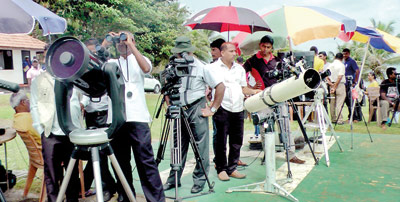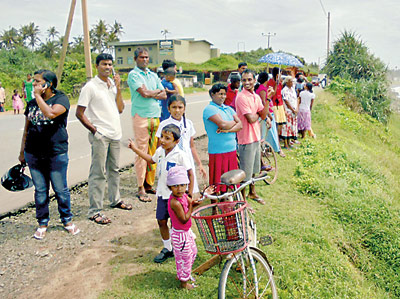News
Friday the 13th space debris was no horror
The eyes of many were focused skyward around noon on Friday the 13th in anticipation of observing the much-hyped space debris predicted to fall into the sea off the southern coast.

People flocked to the Arthur C. Clarke centre in Tangalle. Pic by Rahul Hettiarachchi
Local and foreign space observers camped out at several locations to witness traces of falling debris but no sign of it could be observed from land in the cloudy sky.
The falling debris was, however, observed from an airborne chartered jet sponsored by the United Arab Emirates (UAE) space agency to fly above the Indian Ocean near the area where it was predicted to enter the atmosphere at 11.49am.
Proving that their calculations of trajectory were correct, the German, British and UAE astronomers aimed cameras and other high tech equipment out of the aircraft windows to capture the moment of re-entry of the space debris named WT1190F.
Within a few seconds of it entering Earth’s atmosphere, the space junk burst into flame and burnt into ashes without leaving any trace.
“The biggest challenge we faced was the weather, as it was raining in Sri Lanka,” said Dr. Peter Jenniskens of the SETI Institute in the US.
“For much of our flight to the area we saw haze above our flight altitude at 45,000 feet but our navigator, pilot and first officer found a small clearing [in the clouds] and managed to put the aircraft there at the right time. “We had a perfect view of the WT1190F re-entry, which was bright to the naked eye,” he said.
Space debris is manmade material such as spent rocket stages, old satellites and fragments from disintegration, erosion and collisions etc. of objects sent into space.
WT1190F is believed to be part of a rocet used for the Apollo moon mission. Observers estimated it was less than 2m in length.
“About 20,000 pieces larger than about 5cm are tracked in orbit around Earth together with smaller junk generated as a result of space programmes,” said Dr. Kavan Ratnatunga, an astrophysicist who worked with the NASA Hubble Space Telescope.
“They enter the Earth’s atmosphere daily without prior warning, which is a normal phenomenon. But in the case of WT1190F, space observers could predict the time and location at which this space debris would enter atmosphere.

Residents in Matara look out to sea in hope of catching a glimpse of falling debris. Pic by Krishan Jeewaka Jayaruk
With international media announcing it, it became a much-hyped event,” Dr. Ratnatunga said.
WT1190F was first observed on February 18, 2013 by the Catalina Sky Survey, which is a project to discover near-Earth objects (NEOs) such as comets and asteroids that could be potentially hazardous, with the possibility of hitting Earth.
WT1190F was then lost, and reacquired on November 29, 2013. It was again rediscovered on October 3 this year, giving the observers an opportunity to predict its trajectory by comparing records predicting the place and time it would enter the atmosphere.
Reports of WT1190F caused consternation in some quarters – it was reported that many fishing boats in Matara had not gone out on Friday – but science writer Nalaka Gunawardene said many media outlets had exaggerated the scope of the event. They overlooked the fact that it was a relatively small object – less than 2m long – and hollow.
In the worst case scenario of it going astray and landing on the ground, the potential for damage was limited. But such specifics were ignored.
Some presented it as a case of the skies falling down, Mr. Gunawardene pointed out. In the end, it was much ado about something that ground-based observers could not even see.
The episode is not without positive outcomes, having brought foreign astronomers to Sri Lanka to share knowledge. The Arthur C. Clarke Institute for Modern Technologies and University of Ruhuna took a lead role in setting up observation points at Ambalangoda, Matara and Tangalle.
The head of the Physics Department of the University of Ruhuna said the university is working toward obtaining a telescope, so this event could inspire more Sri Lankan enthusiasts to make sky observations.
Nalaka Gunawardene acknowledged that there is indeed a threat of occasional asteroids, comets or other natural space debris causing harm or damage when crashing to Earth.
“There are thousands of near-earth objects (NEOs) that can pose a threat to our planet, so it is important to track and monitor their movements for early detection of any collision courses,” he said.
Space-going countries have teams to look out for NEOs. There are estimated to be 12,745 near-Earth asteroids ranging in size from 1-32km across.
| Facts on space debris When was the first piece of artificial space debris created? Is space debris a problem? How likely is a collision with space debris? What is the minimum size for dangerous damage? Why is space debris so dangerous? A typical impact occurs at a closing velocity of 10 km/sec or 36,000km per hour. Space debris collision expressed in everyday terms: Is anything being done about space debris? The problem is that these programmes do not reduce the amount of debris currently in orbit. Source: Australian Space Academy |

